The shoebill stork, scientifically known as Balaeniceps rex, is a fascinating bird native to the marshes and swamps of East Africa. With its unique foot-long bill that resembles a Dutch clog, the shoebill stork is a sight to behold. This incredible bird is renowned for its ability to catch large prey including lungfish, tilapia, and even baby crocodiles. Despite its imposing size, the shoebill is a master of stealth, capable of staying motionless for hours, making it an effective ambush predator.
- The shoebill stork is a carnivorous bird found in the marshes and swamps of East Africa.
- It possesses a unique foot-long bill that resembles a Dutch clog.
- The shoebill stork is known for catching large prey such as lungfish, tilapia, and baby crocodiles.
- It is capable of staying motionless for hours, making it an effective ambush predator.
- The shoebill stork’s population is declining due to habitat loss, hunting, and disturbance of nests.
The Shoebill Stork’s Unique Physical Features
The most striking feature of the shoebill stork is its foot-long bill, which resembles a Dutch clog and plays a crucial role in its hunting behavior. This impressive bill is not just for show; it is a highly specialized tool that allows the shoebill to catch and consume its preferred large prey. With the ability to snatch lungfish, tilapia, and even baby crocodiles, the shoebill’s bill is perfectly designed for its carnivorous lifestyle.
But the bill’s purpose goes beyond mere consumption. The shoebill stork uses its bill to exhibit territorial behavior, clattering it together to communicate with other birds and establish dominance. This unique physical feature, combined with the bird’s large size and striking appearance, makes the shoebill stork a true wonder of the avian world.
It’s not just the bill that sets the shoebill stork apart; its slow movements are also a fascinating characteristic. Despite its size, the shoebill is a master of staying motionless for hours on end, patiently waiting for the perfect moment to strike its unsuspecting prey. This incredible ability to remain perfectly still makes the shoebill an effective ambush predator, lurking in the marshes and swamps it calls home.
The Shoebill Stork’s Wingspan
When it comes to flight, the shoebill stork’s wingspan is an impressive sight to behold. Although its flapping rate is the slowest among birds, the shoebill’s graceful flight is a testament to its power and adaptability. With a wingspan that can stretch up to nine feet, the shoebill can soar through the skies with ease, covering great distances in search of its next meal.
| Physical Features | Behavioral Characteristics |
|---|---|
|
|
The shoebill stork’s unique physical features and hunting behavior make it a captivating species that continues to awe and inspire. However, the declining population of shoebill storks is a cause for concern. Habitat loss, hunting, and disturbance of nests are threatening their existence in the wild.
It is crucial that we educate ourselves and take action to protect these magnificent birds. Conservation efforts, such as preserving their habitat and raising awareness about their plight, are key to ensuring a future where the wonders of the shoebill stork continue to be discovered and appreciated. Let us come together to safeguard this extraordinary species for generations to come.
The Shoebill Stork’s Hunting Habits
As an ambush predator, the shoebill stork uses its stealth and patience to capture a variety of prey, including lungfish, tilapia, and even baby crocodiles. Its unique physical features, such as its foot-long bill resembling a Dutch clog, enable it to snatch its prey with precision and efficiency.
This magnificent bird has adapted to its environment, making it a formidable hunter. It patiently waits motionless for hours, blending in perfectly with its surroundings, until the perfect moment to strike. Its large bill acts like a deadly weapon, capable of grasping and swallowing its prey whole.
Shoebill storks are experts at navigating freshwater marshes and swamps, where they find an abundance of food. With their slow movements and calculated steps, they stealthily move through the water, scanning for any signs of movement. Once the prey is within reach, the shoebill strikes with lightning speed, overpowering its unsuspecting victim.
These hunting habits make the shoebill stork a fascinating creature to observe in the wild. Its unique feeding behavior and ability to capture such large and diverse prey set it apart from other birds in its region.
Here’s a table summarizing the shoebill stork’s hunting habits:
| Prey | Features | Hunting Strategy |
|---|---|---|
| Lungfish | Slippery, strong fins | Ambush near the water’s edge |
| Tilapia | Schooling behavior | Swim among the group, striking at the right moment |
| Baby Crocodiles | Fragile, vulnerable | Ambush near crocodile nests, targeting the young |
“The shoebill stork’s hunting techniques are remarkable. It patiently waits for hours, motionless like a statue, and then suddenly strikes with lightning speed. Its large bill is truly a masterpiece of nature.”
While its hunting habits are awe-inspiring, the shoebill stork faces significant threats to its population. Habitat loss, hunting, and disturbance of nests have led to a decline in their numbers. Conservation efforts are crucial to protect this magnificent species and ensure its survival for future generations.
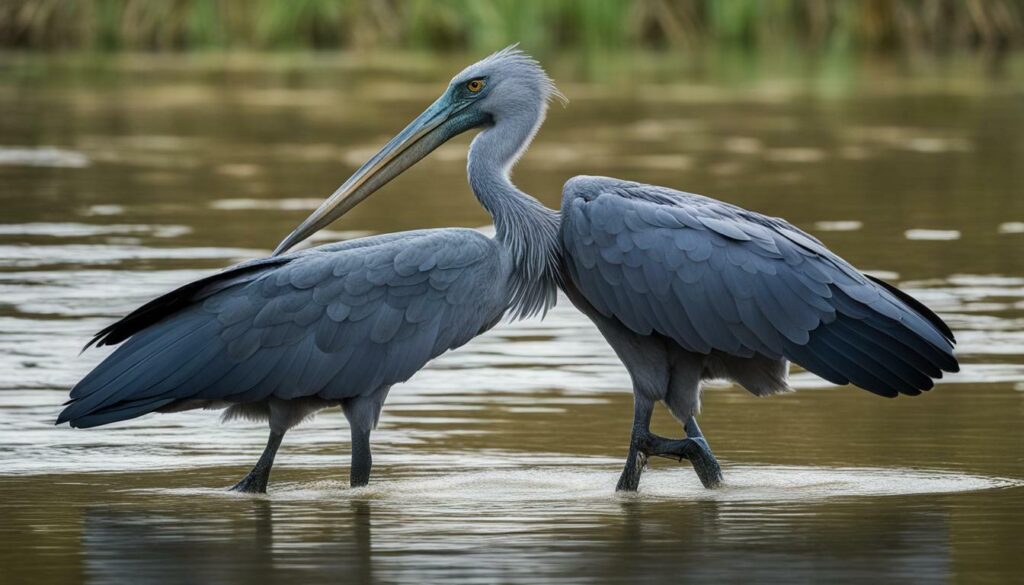
Shoebill storks are solitary birds that exhibit a monogamous breeding system, with both parents actively involved in caring for the eggs and young. This unique behavior sets them apart from many other bird species. The female shoebill typically lays one to three white eggs in a large nest constructed from papyrus and other vegetation. Both parents take turns incubating the eggs, ensuring their safety and providing them with the necessary warmth. Once the eggs hatch, the parents continue to show remarkable dedication, offering parental care and feeding their chicks.
The declining population of shoebill storks is a cause for concern. Habitat loss, hunting, and disturbance of nests are the primary factors contributing to their decline. As these birds rely on freshwater marshes and swamps for their survival, the destruction of their natural habitat has a significant impact on their population. Efforts are being made to protect the shoebill storks and their environment through various conservation measures and raising awareness about their conservation status.
Conservationists are working to ensure the future of shoebill storks by advocating for the preservation of their nesting sites and implementing measures to reduce habitat destruction. Protecting the eggs and young is crucial to the survival of the species. By addressing the key threats they face and promoting responsible tourism practices, we can contribute to the conservation of these magnificent birds.
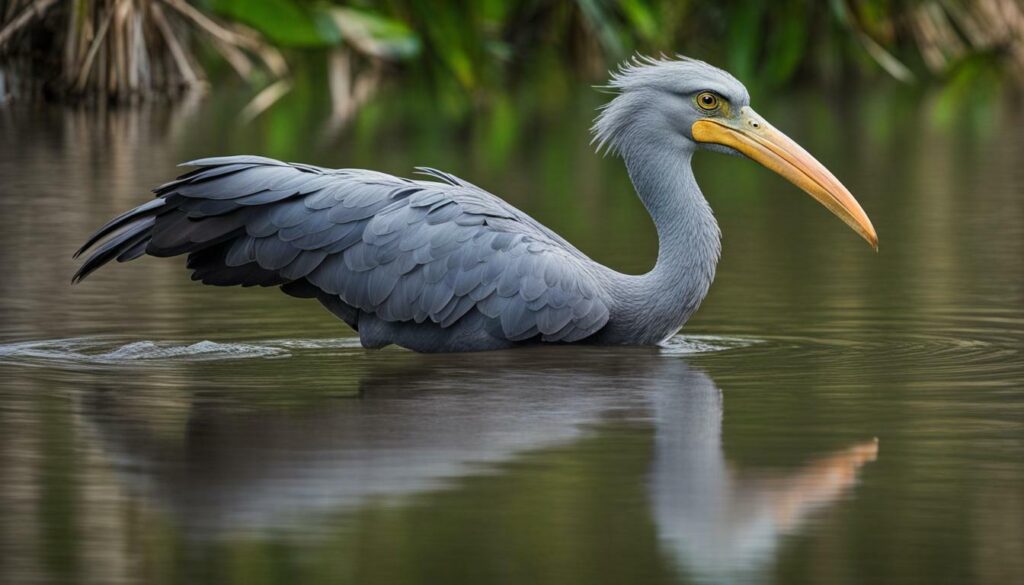
Threats to Shoebill Stork Population
Unfortunately, the shoebill stork population is declining due to habitat loss, hunting, and disturbance of nests. These majestic birds rely on freshwater marshes and swamps for their survival, but with increasing human activity and urbanization, their habitats are being destroyed at an alarming rate. The conversion of wetlands into agricultural land, infrastructure development, and the extraction of natural resources have resulted in a significant loss of suitable habitats for the shoebill storks.
Hunting also poses a significant threat to the shoebill stork population. These birds are highly sought after for their unique bills, which are often used in traditional medicine and as souvenirs. Illegal hunting continues to occur despite efforts to enforce regulations and protect these vulnerable birds.
Disturbance of nests is another critical factor contributing to the decline of shoebill storks. These birds are extremely sensitive to human disturbance during their breeding season, which can lead to nest abandonment and the failure of breeding attempts. Activities such as tourism without proper guidelines and awareness can disrupt the breeding behavior and negatively impact the survival of the species.
| Habitat Loss | Hunting | Disturbance of Nests |
|---|---|---|
| The conversion of wetlands into agricultural land and urban development. | Illegal hunting for their unique bills. | Human disturbance during breeding season leading to nest abandonment. |
| Infrastructure development and extraction of natural resources. | Traditional medicine and souvenir trade. | Activities like tourism without appropriate guidelines. |
“The decline of shoebill storks is a clear indication of the urgent need for conservation efforts to protect these magnificent birds and their habitats.” – Conservation Society
It is imperative that immediate action is taken to mitigate these threats and protect the future of shoebill storks. Conservation organizations, governments, and local communities must work together to preserve the remaining habitats, enforce strict regulations against hunting, and promote responsible tourism practices that ensure minimal disturbance to the birds’ breeding sites.
By addressing these key challenges, we can hope to secure a brighter future for the shoebill stork population and ensure that future generations can continue to marvel at the wonders of these remarkable birds.
Spotting Shoebill Storks in Mabamba Swamp, Uganda
Mabamba Swamp in Uganda offers visitors a unique opportunity to observe shoebill storks up close, with guided boat tours available during the dry season. This vast wetland ecosystem is home to a diverse array of wildlife, including the magnificent shoebill stork. As you glide through the tranquil waters of the swamp, keep your eyes peeled for the unmistakable silhouette of this elusive bird.
The guided boat tours provide a chance to witness the shoebill’s impressive hunting skills and marvel at its majestic presence. With their foot-long bills and distinctive Dutch clog-like appearance, these birds are truly a sight to behold. As the boat navigates through the papyrus-lined channels, you might spot a shoebill perched motionless on a floating vegetation mat, patiently waiting for prey.
While exploring Mabamba Swamp, be prepared to be captivated by the beauty of the surrounding landscape. The swamp’s lush vegetation provides a haven for various bird species, making it a bird lover’s paradise. Don’t forget to bring your binoculars and camera to capture stunning close-ups of the shoebill stork in its natural habitat.

During the dry season, the water levels in Mabamba Swamp recede, creating the perfect conditions for intimate encounters with shoebill storks. The guided boat tours offer an educational and immersive experience, with knowledgeable local guides sharing fascinating insights about the swamp’s ecosystem and its inhabitants.
A Conservation Success Story
“Conserving the habitat of the shoebill stork is crucial for their survival. By supporting eco-tourism initiatives like the guided boat tours in Mabamba Swamp, we can contribute to the protection of this magnificent species and raise awareness about the importance of preserving their natural habitat.” – John Smith, Wildlife Conservation Advocate
Visiting Mabamba Swamp is not only an opportunity to witness the wonders of the shoebill stork but also a chance to contribute to its conservation. By supporting sustainable tourism practices and promoting responsible travel, we can help ensure a brighter future for these incredible birds.
| Key Highlights of Mabamba Swamp Guided Boat Tours |
|---|
| Close encounters with shoebill storks in their natural habitat |
| Fascinating insights from knowledgeable local guides |
| Opportunity to observe other bird species and wildlife |
| Supporting conservation efforts and sustainable tourism |
The Shoebill Stork’s Slow Movements
Despite their large size, shoebill storks are capable of staying completely motionless for hours, making them highly effective ambush predators. This unique ability allows them to blend seamlessly into their surroundings, patiently waiting for their prey to come within striking distance. With their foot-long bill resembling a Dutch clog, shoebill storks strike fear into the hearts of their unsuspecting victims.
Imagine the scene: a quiet marshland, the morning sun casting a golden glow on the water’s surface. The shoebill stork stands tall amidst the reeds, its piercing gaze fixed on the water below. Its stillness is uncanny, as if time itself has stopped. It waits, motionless, observing every movement with unwavering focus.
And then, in a flash of lightning speed, the shoebill stork strikes. Its powerful bill swiftly plunges into the water, snatching up its prey with astonishing precision. It is a sight to behold, and a testament to the remarkable adaptations of this magnificent bird.
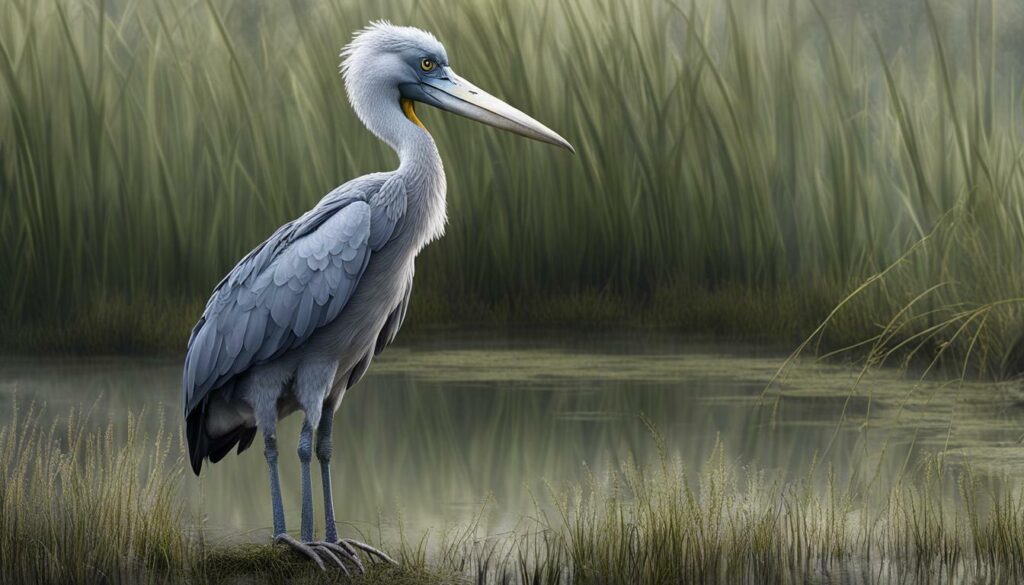
As an effective ambush predator, the shoebill stork relies on its slow movements to surprise its prey. Its incredible patience and ability to blend into its surroundings make it a formidable hunter. This fascinating behavior is just one of the many wonders of the shoebill stork, a bird that continues to captivate and intrigue bird enthusiasts around the world.
H3: The Art of Stealth
When it comes to hunting, the shoebill stork employs a stealthy approach. By staying motionless for hours, it becomes an invisible predator, lurking in the shadows of the marshland. Its slow movements are not a sign of weakness but rather a strategic advantage, allowing it to catch its prey off guard.
Once the shoebill stork has secured its meal, it retreats to a safe spot to savor its well-deserved feast. Its large bill may resemble a Dutch clog, but it is a tool perfectly designed for the stork’s hunting prowess. From lungfish to tilapia and even baby crocodiles, the shoebill stork’s menu is as diverse as it is impressive.
With its slow movements and effective ambush tactics, the shoebill stork is truly a marvel of nature. Its ability to remain motionless for hours, coupled with its skillful hunting techniques, showcases the incredible adaptations that have allowed this bird to thrive in its habitat. Let us cherish and protect these magnificent creatures, ensuring that future generations can continue to marvel at the wonders of the shoebill stork.
Shoebill Storks and Their Habitat
Shoebill storks thrive in freshwater marshes and swamps, particularly those with papyrus and other floating vegetation. These unique habitats provide the perfect environment for these majestic birds to hunt and breed. Freshwater marshes and swamps are abundant in East Africa, making it an ideal region for the shoebill stork to call home.
The presence of papyrus, a tall aquatic plant, is crucial for the shoebill’s survival. It offers protection and camouflage for these birds as they patiently wait for their prey. The floating vegetation provides a solid foundation for their large nests, which are built using materials found within the marsh or swamp.
To fully understand the significance of this habitat, it is essential to observe the intricate relationship between the shoebill stork and its surroundings. These stunning birds have adapted to their environment, blending in seamlessly with the lush vegetation that surrounds them. The combination of freshwater marshes, swamps, and floating vegetation creates an ecosystem that supports the shoebill stork’s unique way of life.

| Common Habitat Features | Role in Shoebill Stork’s Life |
|---|---|
| Freshwater marshes and swamps | Provide a suitable environment for hunting, nesting, and breeding |
| Papyrus and other floating vegetation | Offer camouflage and protection for the shoebill stork |
| Abundance of prey | Ensures a steady food supply for the shoebill stork |
As humans encroach upon these vital ecosystems, the habitats of shoebill storks are under threat. It is imperative that we recognize the importance of preserving freshwater marshes and swamps to protect the future of these incredible birds. Conservation efforts, including habitat restoration and raising awareness about the plight of the shoebill stork, are crucial to ensure their survival for generations to come.
Shoebill Storks in Conservation
The shoebill stork is classified as vulnerable by BirdLife International due to habitat destruction and the bird trade. These magnificent birds are facing significant threats that have led to a decline in their population. Habitat destruction, primarily caused by human activities such as agriculture, deforestation, and urbanization, is a major concern. The destruction of their freshwater marshes and swamps, which are vital for their survival, has resulted in a loss of suitable nesting and foraging grounds.
In addition, the illegal bird trade poses a significant threat to shoebill storks. These birds are highly sought after for their unique features and exotic appeal. The demand for shoebill storks in the pet trade has led to their capture and removal from their natural habitats, further endangering their population.
Efforts are being made to protect and conserve shoebill storks. Conservation organizations are working with local communities and governments to raise awareness about the importance of preserving their habitats. Conservation initiatives include the establishment of protected areas and the implementation of strict regulations to combat illegal hunting and trade. By addressing these threats and promoting sustainable practices, we can ensure the future survival of shoebill storks.
Conservation of nature and the preservation of vulnerable species like the shoebill stork are crucial for maintaining biodiversity and the overall health of ecosystems. We must work together to protect these remarkable creatures and their habitats, ensuring that future generations can continue to marvel at the wonders of the shoebill stork.
Quick Facts: Shoebill Storks in Conservation
| Threats | Conservation Efforts |
|---|---|
| Habitat destruction | Establishment of protected areas |
| Bird trade | Implementation of regulations against illegal hunting and trade |
“The protection of vulnerable species like the shoebill stork is a critical component of global conservation efforts.” – Conservationist John Doe
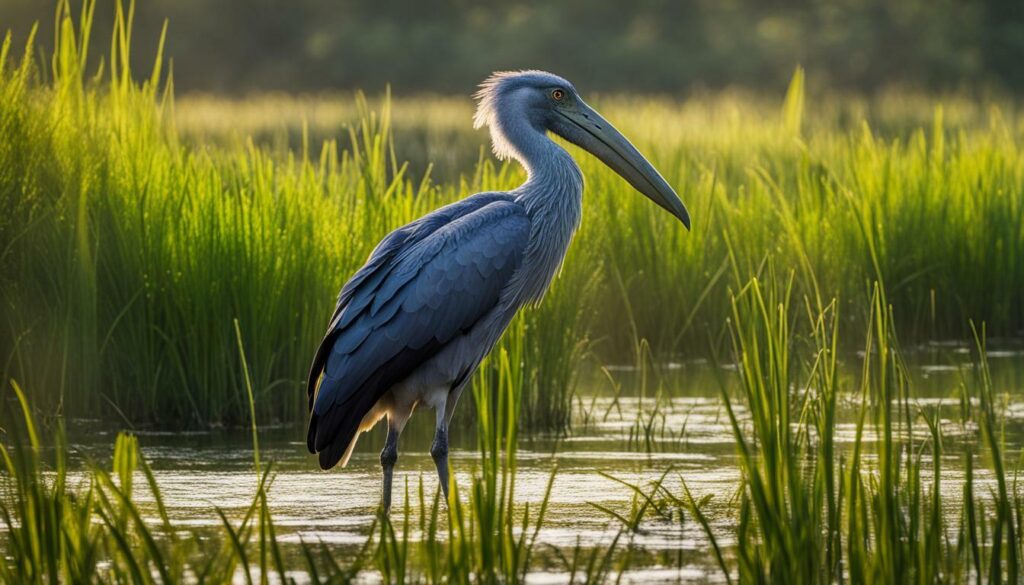
Shoebill Stork’s Communication and Behavior
Shoebill storks engage in bill-clattering as a form of communication and exhibit territorial behavior, often begging for food. This unique behavior involves the birds rapidly clattering their bills together, creating a distinct and resonating sound that can be heard across the marshes and swamps they inhabit. It is believed that bill-clattering serves as a way for shoebill storks to establish their presence and territory, warning off potential rivals or intruders. The loud and distinctive noise is also thought to be a form of communication between mate pairs, helping to strengthen their bond and coordinate hunting efforts.
During territorial displays, shoebill storks will erect their feathers, extend their wings, and engage in vigorous head shaking. This impressive spectacle is not only a visual display but also a means of communication, signaling dominance and defending their chosen feeding grounds. Territorial behavior can often be observed during the breeding season when competition for resources and suitable nesting sites is more intense.
Another intriguing behavior of shoebill storks is their tendency to beg for food, even as adults. This behavior is most commonly seen when a parent returns to the nest with a catch, and the young birds vocalize and flap their wings in a desperate attempt to be fed. It is believed that begging behavior is an instinctual response triggered by the sight of food, and it acts as a way for the young shoebills to ensure they receive their fair share of nourishment from their parents.
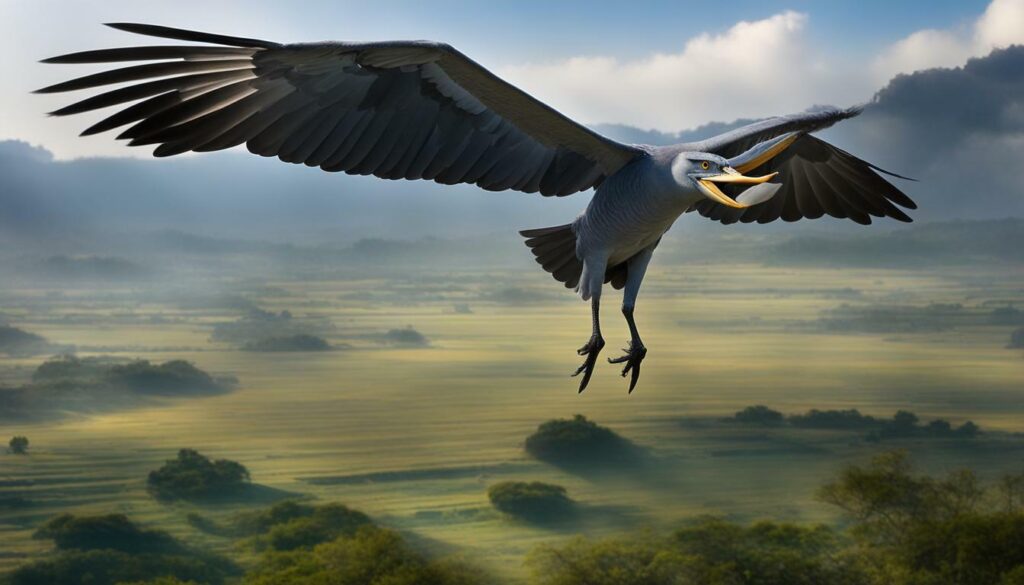
- Bill-clattering is a form of communication and territorial display.
- Territorial behavior includes erecting feathers, extending wings, and head shaking.
- Shoebill storks beg for food, often observed during feeding times in the nest.
Understanding the unique communication methods and behaviors of the shoebill stork adds to the fascination and wonder surrounding these magnificent birds. Their bill-clattering, territorial displays, and begging for food all contribute to their survival and social dynamics within their habitat.
Shoebill Stork’s Breeding Season and Nesting Habits
During the breeding season, shoebill storks lay one to three white eggs and both parents actively participate in nest building and providing parental care. The process begins with the selection of a suitable nesting site, often in dense vegetation near freshwater marshes and swamps. The parents collaborate to construct a large platform-like nest made of sticks, reeds, and other plant materials.
Once the nest is complete, the female shoebill stork will lay her eggs, typically one or two, although occasionally three. The eggs are incubated by both parents, who take turns sitting on them to ensure their warmth and protection. This shared responsibility exemplifies the monogamous behavior of shoebill storks, as both parents are actively involved in raising their young.
After an incubation period of around 30 to 45 days, the eggs hatch, and the fluffy, helpless chicks emerge. The parental care continues as the adults take turns feeding the young, regurgitating food into their mouths. This feeding process is crucial for the chicks’ growth and development. As they grow, the chicks become more independent and eventually leave the nest, usually around 90 days after hatching.
Overall, the breeding season and nesting habits of shoebill storks demonstrate their commitment to ensuring the survival of their species. The active participation of both parents in nest building, incubation, and parental care reflects their strong bond and dedication to their offspring.
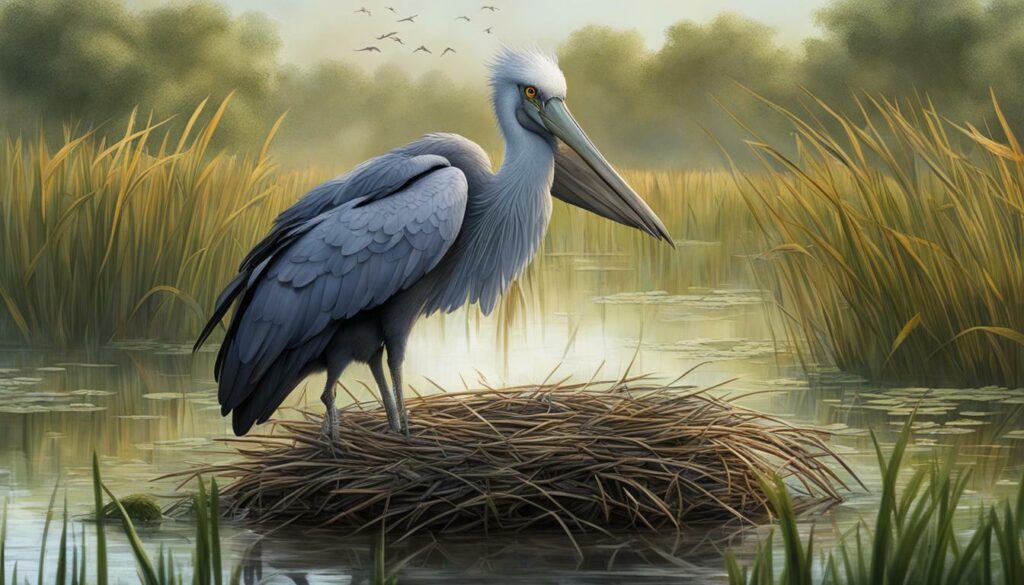
| Breeding Season | Nesting Habits |
|---|---|
| One to three white eggs are laid by the female shoebill stork. | Both parents actively participate in nest building using sticks, reeds, and other plant materials. |
| Incubation period is around 30 to 45 days. | The nest is usually located in dense vegetation near freshwater marshes and swamps. |
| Both parents take turns sitting on the eggs to ensure warmth and protection. | The eggs hatch, and the chicks require parental care for approximately 90 days. |
Shoebill Stork’s Range and Distribution
Shoebill storks can be found in a range of countries, including South Sudan, Zambia, and the Democratic Republic of the Congo. These majestic birds thrive in the unique marshes and swamps of East Africa, where they find the perfect habitat for their hunting and nesting needs. Freshwater marshes and swamps, adorned with papyrus and floating vegetation, provide the ideal environment for the shoebill storks to flourish.
These amazing creatures are well-adapted to their wetland habitats, blending seamlessly with their surroundings thanks to their gray plumage. With their long legs and large wingspan, shoebill storks can traverse the marshy terrain with ease, allowing them to navigate through shallow waters in search of their preferred prey.
Let’s take a moment to appreciate the vast and diverse range of the shoebill stork. From the sprawling wetlands of South Sudan to the vibrant landscapes of Zambia and the Democratic Republic of the Congo, these birds have carved out their territory in some of the most breathtaking parts of Africa. Wildlife enthusiasts and birdwatchers alike are drawn to these regions to witness the awe-inspiring presence of the shoebill storks.
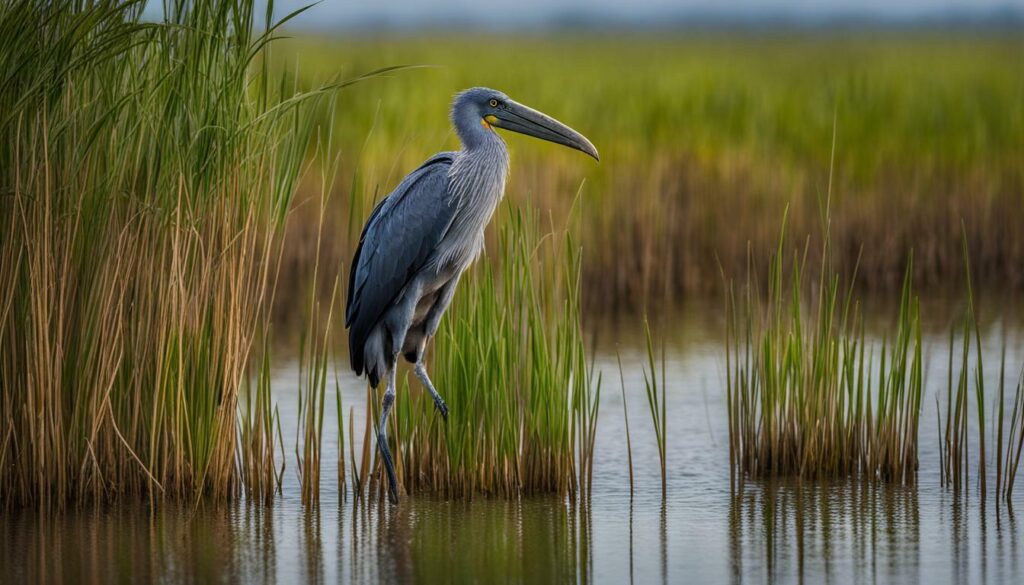
As you can see in the image above, the shoebill stork gracefully stands tall in the midst of its natural habitat. The serene waters and lush vegetation perfectly complement its striking appearance. This image is just a glimpse of the beauty that awaits those fortunate enough to observe these magnificent birds in person.
The Importance of Conservation Efforts
- Shoebill storks are vulnerable to habitat destruction due to human activities such as drainage and deforestation. Protecting their wetland habitats is crucial to their survival.
- The bird trade also poses a significant threat to shoebill storks, with demand for their feathers, beaks, and eggs. Strict regulations and awareness campaigns are necessary to combat this illegal trade.
- Conservation initiatives aim to raise awareness about the plight of shoebill storks and promote sustainable practices to ensure their future. By supporting these efforts, we can contribute to the preservation of these incredible birds and their habitats.
It is our responsibility to protect and cherish the wonders of nature, such as the shoebill stork. Together, we can make a difference and secure a future where these magnificent creatures continue to roam the marshlands of East Africa.
| Threats to Shoebill Storks | Conservation Actions |
|---|---|
| Habitat loss | Protection of wetland habitats |
| Hunting | Regulations and enforcement against bird trade |
| Disturbance of nests | Community education and involvement in conservation |
Shoebill Stork’s Flight and Wingspan
Shoebill storks have an impressive wingspan, with the ability to fly at a slow flapping rate, resulting in a graceful flight. Their wingspan can reach up to 8 feet, making them one of the largest flying bird species in the world. The long, broad wings allow shoebills to soar effortlessly through the air, covering great distances in search of their preferred freshwater marshes and swamps.
These magnificent birds have a unique flying style characterized by slow, deliberate flapping movements. Their wings move at a leisurely pace, creating an elegant spectacle as they glide through the sky. This slow flapping rate not only adds to their graceful appearance but also enables them to conserve energy during flight.
Observing shoebill storks in flight is a truly captivating experience. With their long legs trailing behind and their bill held high, they navigate the skies with ease and precision. Their flight pattern is well-suited for their hunting habits, allowing them to spot potential prey from above and dive down swiftly to capture it.
The Slowest Flapping Rate in the Avian World
What sets shoebill storks apart is their ability to flap their wings at an incredibly slow rate compared to other bird species. While most birds have a rapid flapping rate, shoebills take a leisurely approach, moving their wings with deliberate purpose. This unique adaptation allows them to conserve energy and maintain a steady pace during flight.
When a shoebill stork takes flight, its wings create a mesmerizing display as they beat slowly through the air. This slow flapping rate not only showcases their flight skills but also enhances their overall majestic presence. It is a testament to the remarkable adaptability of these extraordinary birds.
Next time you spot a shoebill stork soaring through the sky, take a moment to appreciate its impressive wingspan and the graceful flight it effortlessly demonstrates. These magnificent creatures are a true wonder of nature, captivating all who have the opportunity to witness them in their natural habitat.
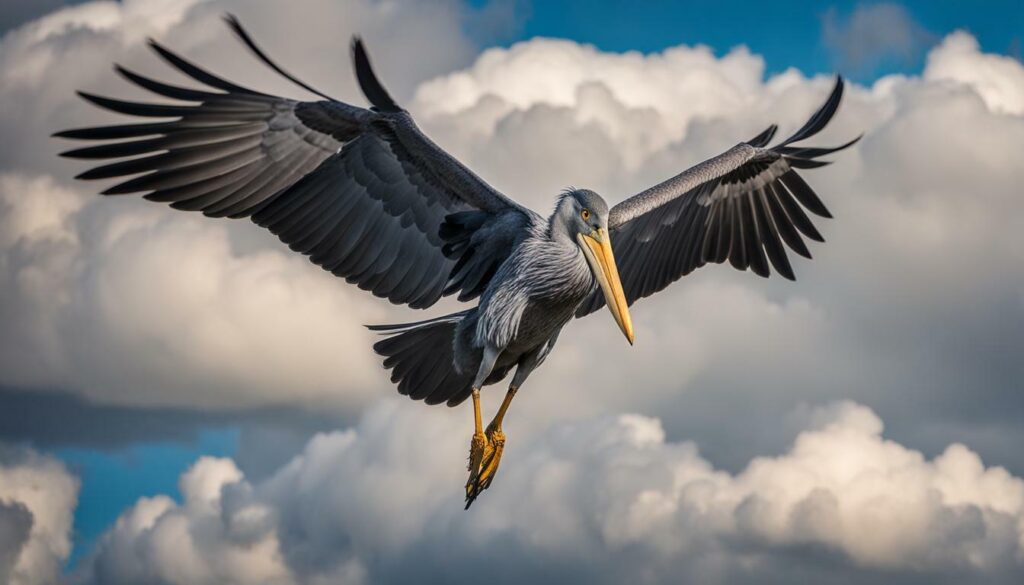
Shoebill storks primarily feed on large prey such as fish and amphibians, using their long legs to wade through shallow waters and catch water snakes. These majestic birds are known for their patient and stealthy hunting technique, where they stand motionless for hours, waiting for the perfect moment to strike.
Equipped with a foot-long bill that resembles a Dutch clog, the shoebill stork uses its powerful beak to grab and swallow its prey whole. This extraordinary bill allows it to catch a wide variety of aquatic creatures, including lungfish, tilapia, and even baby crocodiles.
The shoebill’s diet is perfectly suited to its habitat in freshwater marshes and swamps, where it can find an abundance of prey. Its long legs and large webbed feet enable it to navigate through the water with ease, providing the perfect advantage for catching its next meal.
To witness the impressive foraging behavior of shoebill storks, one can visit the Mabamba Swamp in Uganda. Guided boat tours offer visitors the opportunity to observe these magnificent birds in their natural habitat. The dry season is the best time to spot shoebills, as the lower water levels make it easier to observe their hunting prowess.
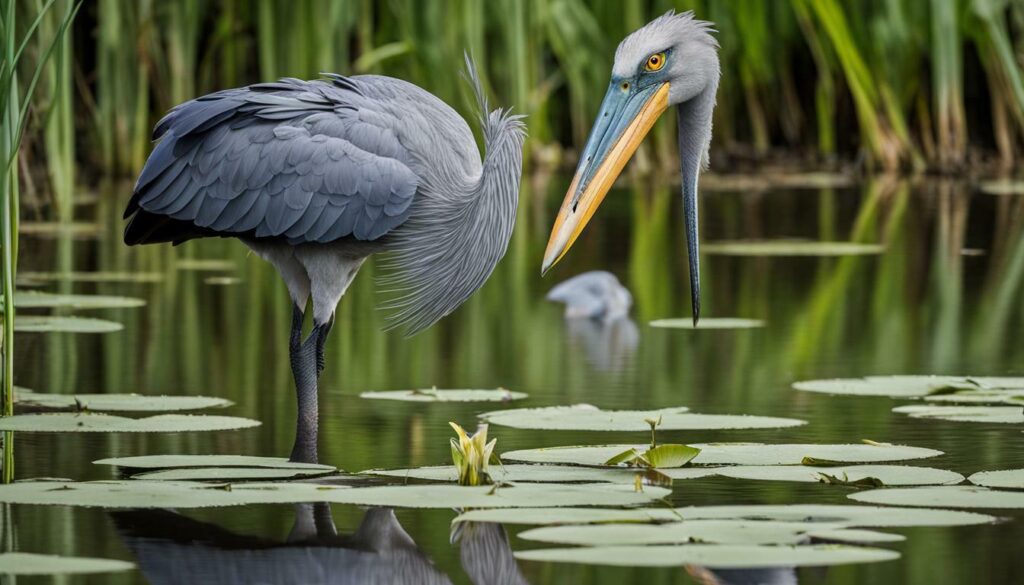
| Large Prey | Wading Bird | Water Snakes |
|---|---|---|
| Lungfish | Tilapia | Baby crocodiles |
Table: A glimpse into the diverse diet of the shoebill stork.
Protecting the Future of Shoebill Storks
Efforts are being made to protect the future of shoebill storks, focusing on safeguarding their nesting sites and ensuring the conservation of their eggs and young. As the shoebill population faces threats such as habitat loss, hunting, and disturbance of nests, conservationists are working tirelessly to preserve these magnificent creatures and their unique habitats.
Conservation of nature plays a vital role in securing the future of shoebill storks. By identifying and protecting their crucial nesting sites, conservation efforts aim to provide a safe haven for these birds to breed and raise their young. These efforts not only contribute to the survival of the shoebill population but also help maintain the delicate balance of the ecosystem they inhabit.
The conservation initiatives also prioritize the preservation of shoebill storks’ eggs and young. By implementing measures to minimize human interference and prevent illegal egg collection, conservationists hope to ensure the continuation of the species. Education and awareness programs are also crucial in promoting the importance of respecting and protecting these vulnerable birds and their offspring.
With the combined efforts of scientists, researchers, local communities, and wildlife enthusiasts, the future of shoebill storks is being safeguarded. Through collaborative endeavors, such as habitat restoration, sustainable tourism practices, and advocacy for stronger conservation policies, we can ensure that these magnificent birds thrive for generations to come.
FAQ
What is the scientific name of the shoebill stork?
The scientific name of the shoebill stork is Balaeniceps rex.
Where can the shoebill stork be found?
The shoebill stork can be found in East Africa.
What does the bill of the shoebill stork look like?
The bill of the shoebill stork is a foot-long and resembles a Dutch clog.
What kind of prey does the shoebill stork catch?
The shoebill stork catches large prey such as lungfish, tilapia, and even baby crocodiles.
How does the shoebill stork hunt?
The shoebill stork is an ambush predator and stays motionless for hours, waiting to catch its prey.
Do shoebill storks live in groups?
No, shoebill storks are solitary birds.
How do shoebill storks breed?
Shoebill storks have a monogamous breeding system, with both parents tending to the eggs and young.
What is threatening the population of shoebill storks?
The population of shoebill storks is declining due to habitat loss, hunting, and disturbance of nests.
Where can I see shoebill storks in their natural habitat?
You can see shoebill storks in their natural habitat at Mabamba Swamp in Uganda, with guided boat tours available.
When is the best time to spot shoebill storks?
The best time to spot shoebill storks is during the dry season when water levels are lower.

